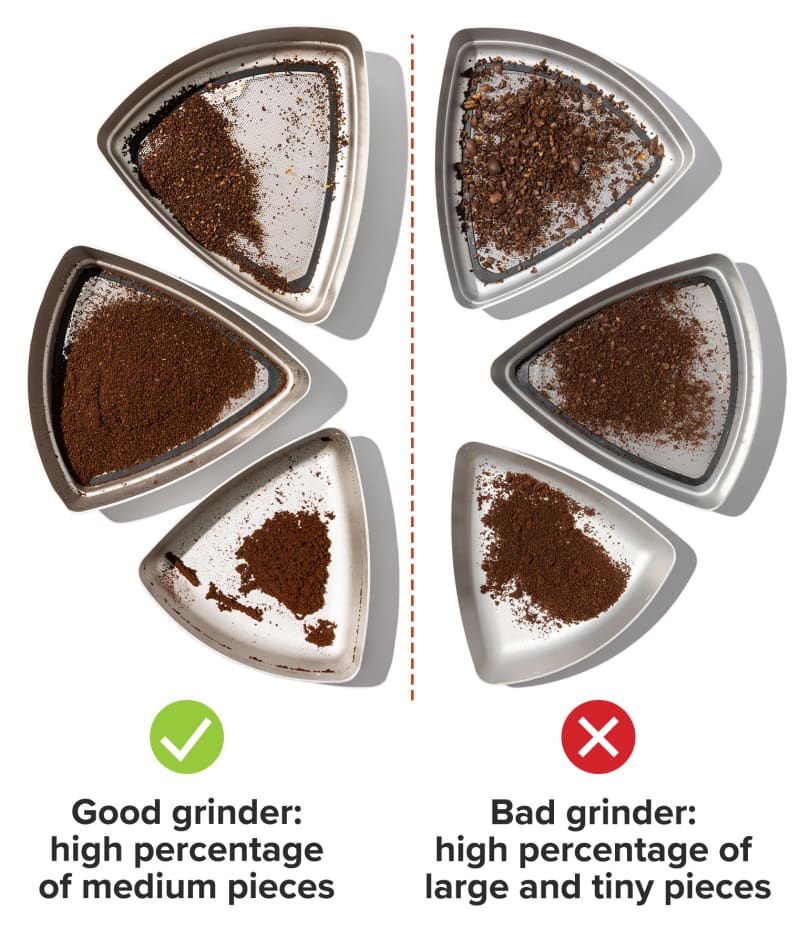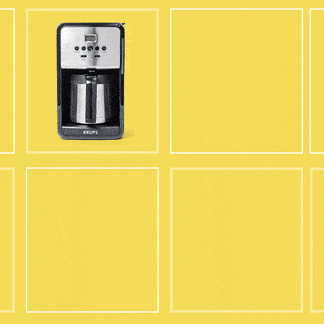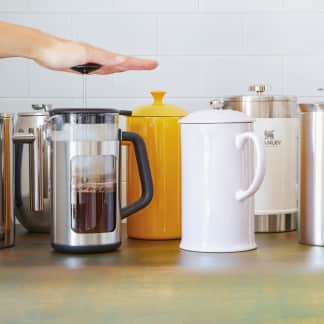While many factors contribute to the flavor of brewed coffee, a good burr coffee grinder is essential to ensuring consistent quality from drip to espresso and everything in between. Our favorite, the Baratza Encore ESP, is an easy-to-use, reliably consistent grinder that offers an ample number of precise grind sizes. If you’re a serious espresso drinker, consider upgrading to the Baratza Sette 270 for the massive amount of additional settings on the finer end of the spectrum, which give you more runway to finesse your shots.

Burr coffee grinders are the gold standard in the coffee industry. Their pepper mill–like, grooved burrs spin against each other to transform whole beans into smaller particles. Unlike blade coffee grinders (for more information about blade grinders, see the FAQ below), burr grinders can repeatedly produce evenly ground coffee beans, ensuring consistency in your brewed coffee. Another advantage is that they are customizable. With a number of grind size settings from fine to coarse, burr grinders allow home coffee hobbyists to easily switch from grinding beans for cold-brew coffee on a hot summer day to a velvety espresso after dinner and everything in between.
How to Clean Your Burr Coffee Grinder
So you took the leap and splurged on a burr coffee grinder. Here’s how to ensure that you’re cleaning it properly.To find the best burr grinder, we ground 110 pounds of light, medium, and dark roast coffee beans to various finenesses. Generally, coffee grounds can be categorized into three sizes: medium pieces, larger “boulders,” and smaller “fines.” Fines can release unappealing bitter flavors, while boulders take longer to release flavors, resulting in weak coffee. In theory, the larger the percentage of medium pieces in your ground coffee, the more evenly extracted and flavorful your brewed coffee will be.
To see whether this was the case and to judge how evenly the grinders ground coffee, we sifted final ground products from each model through a set of Kruve sifters, a tool used by baristas to determine grind size and verify burr grinders’ quality.

We then held tastings with our colleagues as well as coffee professionals from Counter Culture Coffee and George Howell Coffee, comparing coffees brewed with grounds produced by each grinder. We used refractometers to record the Total Dissolved Solids (TDS) of each batch of coffee we brewed, an industry standard practice used to gauge the number of flavor compounds in coffee. Because a high TDS reading doesn’t always equate to a good-tasting cup (the Specialty Coffee Association’s guideline is from 1.15 percent to 1.35 percent), we used the readings to evaluate the consistency and repeatability of each model. We also compared the burr grinders to our winning blade grinder.
How Burr Grinders Work
A burr grinder has three sections: a hopper where you load the beans, a grinding chamber, and a bin that catches the ground coffee. Inside the grinding chamber, you’ll find two steel rings called burrs (they can be made of ceramic). The rings are either stacked on top of each other (known as flat burrs) or one inside the other (known as conical burrs). The burrs of all the machines in our lineup were steel. The distance between the rings, which is adjustable, controls how finely the beans are ground. To operate, you load the beans into the hopper and grind them right before brewing the coffee. Some grinders are equipped with timers, which allow you to grind for a set amount of time (this grinding time corresponds to a desired specific amount of grounds). Most of the grinders in our lineup have timers. However, we recommend weighing the coffee on a precision coffee scale before you grind, which offers more accuracy, because different types of beans are different sizes and shapes; relying on a timer may not offer the most precise result. We followed these instructions in our testing.
The Best Burr Coffee Grinders
Some grinders were customizable, tidy, and luxurious, while others were a pain and left our counters dusted with coffee grounds. Here’s what mattered.
What to Look For
- Number of Settings: For a basic burr grinder, look for at least 10 grind settings; this number allows you to produce grounds for a variety of brewing methods and to customize within each method. For a grinder that excels at espresso, we found that machines with at least 40 settings and lots of finer options offered the range and tiny increments of adjustment desired by espresso fans.


We preferred models with at least 10 settings to brew different types of coffee. For people who switch between brewing methods often, we recommend at least 40 settings to fully take advantage of tinkering the grind size to brew a good-tasting coffee.
- Fewer Stray Grounds: The contact between metal burrs and coffee beans causes electricity discharge, which causes grounds to cling to surfaces. We liked models that produced minimal stray grounds and static cling, both of which wasted coffee and made a mess.
- A Heavy Base: The grinding motor can cause the machine to rattle. A heavy base that weighed 5 pounds or more helped secure the grinder in place.
- Clear Markings and Labels: We liked models with markings that helped us easily adjust the grind size.

- Detachable and Replaceable Parts: We preferred machines that were easy to take apart and clean. One finicky model required us to watch videos online in order to disassemble the machine. Others had burrs permanently affixed to their bases, so we couldn’t take them apart to clean or unclog them. We also preferred models from manufacturers that sell replacement parts, which are less expensive and less wasteful than buying a new model, and small fixes here and there can keep these machines running for years.
- User-Friendly Grounds Container Design: We liked the containers that had sharp edges that helped us more easily angle and dispense grounds into a coffee maker.
What to Avoid
- Fewer Than 10 Settings: To make the investment worthwhile, we recommend choosing a burr grinder that has a high number of settings—from coarse to fine—designed for different brewing methods. Fewer settings meant we couldn’t easily make different styles of coffee. If you want to brew espresso, be sure to choose models with 40 or more settings.
- Lightweight Grinders: Lightweight models seemed fine when grinding smaller amounts of beans, but we noticed they became unstable when grinding large amounts of coffee and threatened to tip over.
- Confusing Labeling: We struggled with deciphering the symbols and markings on some models. We preferred the models that had clear, intuitive markings to guide us through the different grind settings with their corresponding brewing methods.


One thing to consider when shopping for burr grinders is the type of burrs the machine uses. In our taste test, we didn’t find discernible differences between coffee made with grounds from a conical burr grinder and that from a flat burr grinder.
Other Considerations
- Flat Burrs versus Conical Burrs: Machines with flat burrs are generally more expensive than those with conical burrs. In our testing, we didn’t find discernible differences between the coffee grounds produced by the two types of burrs. Conical burrs are more economical than flat burrs, and all our top models had them.
The Tests:
- Grind batches of light, medium, and dark coffee on coarse, medium, and fine settings; evaluate ease of use
- Sift coarse, medium, and fine grounds through Kruve sifter and calculate the percentages of fines and boulders
- Hold a taste test with professionals from George Howell Coffee and Counter Culture Coffee and average coffee drinkers, asking them to sample coffee brewed with grounds produced by each grinder using the same coffee beans and brewing method
- For the grinders suitable for espresso, use each grinder to produce grounds for espresso, according to SCA guidelines
- Record the Total Dissolved Solids (TDS) value of coffee made in each model using a refractometer two times and comparing the two numbers
- Clean up each grinder using Grindz tablets, per expert advice
How We Rated
- Performance: We made coffee with beans ground by each machine and then evaluated coffees brewed from these grounds by tasting each and assessing the TDS readings of each batch.
- Ease of Use: We rated how easy it was to use and adjust each grinder for different brewing tasks.
- Cleanup: We rated each grinder on how easy it was to clean. We also rated how easy it was to reassemble the parts after removing them for deep cleaning.
- Versatility: We assessed the number of grind sizes each model offered and determined how versatile they were at producing grounds suitable for different brewing methods.





















